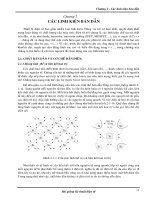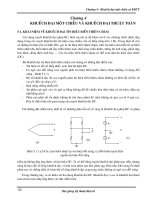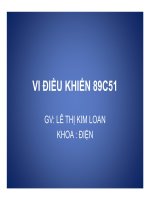Kỹ thuật điện tử Ebook full English
Bạn đang xem bản rút gọn của tài liệu. Xem và tải ngay bản đầy đủ của tài liệu tại đây (22.21 MB, 836 trang )
BASIC ELECTRONICS
Debashis De
With contributions from
Kamakhya Prasad Ghatak
Delhi • Chennai • Chandigarh
BRIEF CONTENTS
Preface
Reviewers
The Author and the Contributor
1 Semiconductor Fundamentals
2 Diode Fundamentals
3 Diode Circuits
4 BJT Fundamentals
5 BJT Circuits
6 Field-Effect Transistor
7 FET Circuits
8 Special Semiconductor Devices
9 Feedback Amplifier
10 Fundamentals of Integrated Circuit Fabrication
11 Operational Amplifier
12 Oscillators
13 Digital Electronic Principles
14 Electronic Instruments
CONTENTS
Preface
Reviewers
The Author and the Contributor
1 Semiconductor Fundamentals
1-1 Introduction
1-2 Crystalline Materials
Semiconducting Materials
1-2-1 Crystals and Crystal Structures
1-2-2 Mechanical Properties
1-2-3 Energy Band Theory
Simplified Derivation of the Fermi–Dirac Statistics
1-3 Basis of Classification: Metals, Semiconductors and Insulators
1-3-1 Insulators (Eg >> 4 eV)
1-3-2 Semiconductors (0 eV ≤ Eg ≤ 4 eV)
1-3-3 Metals (Inter-Penetrating Band Structure)
1-4 Intrinsic Semiconductors
1-5 Extrinsic Semiconductors
1-5-1 Doping
1-5-2 Dopants
1-5-3 Carrier Statistics in n- and p-type Semiconductors
Properties of the Fermi–Dirac Integral
1-6 Electrical Conduction Phenomenon
1-6-1 Mobility
1-6-2 Conductivity
1-6-3 Diffusion of Carriers
1-6-4 Einstein Relation
1-6-5 Recombination and Generation Processes
1-7 The Continuity Equation
1-8 Hall Effect
2 Diode Fundamentals
2-1 Introduction
2-2 Formation of the p–n Junction
2-3 Energy Band Diagrams
2-3-1 The p–n Junction at Thermal Equilibrium
2-4 Concepts of Junction Potential
2-4-1 Space-Charge Region
2-4-2 Built-in and Contact Potentials
2-4-3 Effect of Doping on Barrier Field
Invariance of Fermi Level at Thermal Equilibrium
2-4-4 Formulation of Built-in Potential
2-5 Modes of the p–n Junction
2-5-1 The p–n Junction with External Applied Voltage
2-5-2 Rectifying Voltage–Current Characteristics of a p–n Junction
2-5-3 The Junction Capacitance
2-5-4 The Varactor Diode
2-6 Derivation of the I–V Characteristics of a p–n Junction Diode
2-7 Linear Piecewise Models
2-8 Breakdown Diode
2-8-1 Zener Breakdown
2-8-2 Avalanche Breakdown
2-9 Special Types of p–n Junction Semiconductor Diodes
2-9-1 Tunnel Diode
2-9-2 Light-Emitting Diode
2-9-3 Photo Detector Diode
2-9-4 Photovoltaic Diode
2-10 Applications of Diode
2-10-1 Radio Demodulation
2-10-2 Power Conversion
2-10-3 Over-Voltage Protection
2-10-4 Logic Gates
2-10-5 Ionizing Radiation Detectors
2-10-6 Temperature Measuring
2-10-7 Charge-Coupled Devices
3 Diode Circuits
3-1 Introduction
3-2 Analysis of Diode Circuits
3-3 Load Line and Q-Point
3-4 Zener Diode as Voltage Regulator
3-4-1 Line Regulation
3-4-2 Load Regulation: Regulation with Varying Load Resistance
3-5 Rectifiers
3-5-1 Half-Wave Rectifier
3-5-2 Full-Wave Rectifier
3-5-3 Use of Filters in Rectification
3-5-4 Regulation
3-5-5 Performance Analysis of Various Rectifier Circuits
3-6 Clipper and Clamper Circuits
3-6-1 Clipper
3-6-2 Clamper
3-7 Comparators
3-8 Additional Diode Circuits
3-8-1 Voltage Multiplier
3-8-2 Peak Detector
3-8-3 Digital Circuits
3-8-4 Switching Regulators
4 BJT Fundamentals
4-1 Introduction
4-2 Formation of p–n–p and n–p–n Junctions
4-3 Transistor Mechanism
4-4 Energy Band Diagrams
4-5 Transistor Current Components
4-5-1 Current Components in p–n–p Transistor
4-5-2 Current Components in n–p–n Transistor
4-6 CB, CE and CC Configurations
4-6-1 Common-Base (CB) Mode
4-6-2 Common-Emitter (CE) Mode
4-6-3 Common-Collector (CC) Mode
4-7 Expression for Current Gain
4-7-1 Relationship between α and β
Ebers–Moll Model of Transistor
4-8 Transistor Characteristics
4-8-1 Input Characteristics
4-8-2 Output Characteristics
4-9 Operating Point and the Concept of Load Line
4-10 Early Effect
5 BJT Circuits
5-1 Introduction
5-2 Biasing and Bias Stability
5-2-1 Circuit Configurations
5-2-2 Stabilization Against Variations in ICO, VBE and β
5-3 Calculation of Stability Factors
5-3-1 Stability Factor S
5-3-2 Stability Factor S'
5-3-3 Stability Factor S''
5-3-4 General Remarks on Collector Current Stability
5-4 CE, CB Modes and Their Properties
5-4-1 Common-Emitter (CE) Mode
5-4-2 Common-Base Mode
5-5 Small-Signal Low-Frequency Operation of Transistors
5-5-1 Hybrid Parameters and Two-Port Network
5-6 Equivalent Circuits Through Hybrid Parameters as a Two-Port Network
5-7 Transistor as Amplifier
5-7-1 The Parameter α'
5-8 Expressions of Current Gain, Input Resistance, Voltage Gain and Output Resistance
5-8-1 Current Gain (AI)
5-8-2 Input Resistance (RI)
5-8-3 Voltage Gain (Av)
5-8-4 Output Resistance (RO)
5-9 Frequency Response for CE Amplifier with and without Source Impedance
5-9-1 Conclusions
5-10 Emitter Follower
5-11 Darlington Pair
5-12 Transistor at High Frequencies
5-13 Real-Life Applications of the Transistor
6 Field-Effect Transistor
6-1 Introduction
6-2 The Field-Effect Transistor
6-2-1 Junction Field-Effect Transistor (JFET)
6-2-2 Insulated Gate Field-Effect Transistor (IGFET)
6-2-3 Metal-Semiconductor Field-Effect Transistor (MESFET)
6-3 Construction of the JFET
6-4 Biasing of the JFET
6-4-1 Effect of the Gate Voltage
6-5 Current–Voltage Characteristics
6-6 Transfer Characteristics of the JFET
6-7 Construction and Characteristics of the MOSFET
6-7-1 Depletion-Type MOSFET
6-7-2 Enhancement-Type MOSFET
6-8 Complementary MOS
6-8-1 Construction of the CMOS
6-8-2 CMOS Inverter
Examination of Mosfets under Two Extremes
6-9 Real-Life Applications of the FET
7 FET Circuits
7-1 Introduction
7-2 FET Biasing
7-2-1 Fixed-Bias Arrangement
7-2-2 Self-Bias Arrangement
7-2-3 Voltage Divider Biasing Arrangement
7-3 FET as an Amplifier
7-3-1 DC Bias Point
7-3-2 Voltage Gain of the FET
7-4 Electrical Parameters of the FET
7-5 AC Equivalent Circuit for Small-Signal Analysis
7-5-1 Small-Signal Model for the MOSFET
T Equivalent-Circuit Model
7-6 High-Frequency MOSFET Model
7-6-1 Effective Capacitance of the Gate
7-6-2 The Junction Capacitance
7-6-3 The High-Frequency Models of the MOSFET
7-7 Additional FET Circuits
7-7-1 MOS Differential Amplifiers
7-7-2 Current Source Circuits
7-8 Comparison Between the FET and the BJT
8 Special Semiconductor Devices
8-1 Introduction
8-2 Silicon-Controlled Rectifier (SCR)
8-2-1 Constructional Features
8-2-2 Physical Operation and Characteristics
8-2-3 I–V Characteristics of the SCR
8-2-4 Simple Applications
8-3 Triode AC Switch (TRIAC)
8-3-1 Constructional Features
Physical Operation and Characteristics of the TRIAC
8-4 Diode AC Switch (DIAC)
8-4-1 Constructional Features
8-4-2 Physical Operation and Characteristics
8-4-3 Applications
8-5 Unijunction Transistor (UJT)
8-5-1 Constructional Features
8-5-2 Physical Operation and Characteristics
8-5-3 Applications
8-6 Insulated-Gate Bipolar Transistor (IGBT)
8-6-1 Constructional Features
8-6-2 Physical Operation and Characteristics
8-7 Real-Life Applications
9 Feedback Amplifier
9-1 Introduction
9-2 Conceptual Development Through Block Diagrams
9-2-1 Input Signal
9-2-2 Output Signal
9-2-3 Sampling Network
9-2-4 Comparison or Summing Network
9-2-5 Basic Amplifier
9-3 Properties of Negative Feedback
9-4 Calculations of Open-Loop Gain, Closed-Loop Gain and Feedback Factors
9-4-1 Loop Gain or Return Ratio
9-5 Topologies of the Feedback Amplifier
9-5-1 Voltage-Series or Series-Shunt Feedback
9-5-2 Current-Series or Series-Series Feedback
9-5-3 Current-Shunt or Shunt-Series Feedback
9-5-4 Voltage-Shunt or Shunt-Shunt Feedback
9-6 Effect of Feedback on Gain, Input and Output Impedances
9-6-1 Effect of Feedback on Input Impedance
9-6-2 Effect of Feedback on Output Impedance
9-7 Practical Implementations of the Feedback Topologies
9-7-1 Voltage-Series Feedback Using Transistor
9-7-2 Current-Series Feedback Using Transistor
9-7-3 Voltage-Shunt Feedback Using Transistor
9-7-4 Current-Shunt Feedback Using Transistor
9-8 Sensitivity
9-9 Bandwidth Stability
9-10 Effect of Positive Feedback
9-10-1 Instability and Oscillation
9-10-2 Nyquist Criterion
9-10-3 Condition of Oscillation
9-10-4 Barkhausen Criterion
10 Fundamentals of Integrated Circuit Fabrication
10-1 Introduction
10-2 Fundamentals of Integrated Circuits
10-3 Types of Integrated Circuits
10-3-1 Monolithic IC
10-3-2 Hybrid IC
10-4 Advantages and Disadvantages of Integrated Circuits
10-5 Scale of Integration
10-5-1 Types of IC Chips
10-6 Crystal Growth and Wafer Preparation
10-7 Epitaxial Growth
10-8 Oxidation for Isolation
10-9 Photolithography for Pattern Transfer
10-9-1 Mask Alignment and UV Exposure
10-10 Etching for Design
10-10-1 Wet Chemical Etching
10-10-2 Dry Chemical Etching
10-10-3 Chemical Plasma Etching
10-10-4 Ion Beam Etching
10-10-5 Reactive Ion Etching
10-11 Diffusion for Doping
10-12 Ion Implantation for Doping
10-13 Metallization for Interconnection
10-14 Testing for Reliability
10-15 Packaging Protection
10-16 IC Symbols
10-17 Fabrication Steps for Different Circuits
10-17-1 Fabrication of Resistors in Integrated Circuits
10-17-2 Steps of Fabrication of Capacitors
10-17-3 Steps of Fabrication of the Transistor Circuit
10-17-4 The Schottky Diode
10-17-5 Schematic Diagram of a CMOS Circuit
10-18 Real-Life Applications
11 Operational Amplifier
11-1 Introduction
11-2 Properties of the Ideal Operational Amplifier
11-3 Specifications of IC 741C
11-3-1 Description of Op-Amp 741 IC Pins
11-4 Operational Amplifier and its Terminal Properties
11-4-1 Input Offset Voltage and Output Offset Voltage
11-4-2 Input-Bias Current
11-4-3 Input Offset Current and Output Offset Current
11-4-4 Input Offset Null Voltage
11-4-5 Differential Input Resistance
11-4-6 Input Capacitance
11-4-7 Offset Voltage Adjustment Range
11-4-8 Input Voltage Range
11-4-9 Common-Mode Rejection Ratio (CMRR)
11-4-10 Supply Voltage Rejection Ratio (SVRR)
11-4-11 Large Signal Voltage Gain
11-4-12 Output Voltage Swing
11-4-13 Output Resistance
11-4-14 Supply Voltage
11-4-15 Supply Current
11-4-16 Power Consumption
11-4-17 Slew Rate
11-4-18 Gain Bandwidth Product
11-4-19 Virtual Ground
11-5 Applications of the Operational Amplifier
11-5-1 Inverting Mode of Operation
11-5-2 Non-Inverting Mode of Operation
11-5-3 Voltage Summing, Difference, and Constant Gain Multiplier
11-5-4 Voltage Follower or Unity Gain Amplifier
11-5-5 Comparator
11-5-6 Integrator
11-5-7 Differentiator
11-5-8 Logarithmic Amplifier
11-6 Real-Life Applications
12 Oscillators
12-1 Introduction
12-2 Classifications of Oscillators
12-3 Circuit Analysis of a General Oscillator
12-3-1 Hartley Oscillator
12-3-2 Colpitts Oscillator
12-3-3 Phase-Shift Oscillator
12-3-4 Wien-Bridge Oscillator
12-4 Conditions for Oscillation: Barkhausen Criterion
12-4-1 Nyquist Criterion for Oscillation
12-5 Tuned Oscillator
12-5-1 Circuit Analysis
12-6 Crystal Oscillator
12-7 Real-Life Applications of Oscillators
12-7-1 Voltage-Controlled Oscillator
12-7-2 Cascode Crystal Oscillator
13 Digital Electronic Principles
13-1 Introduction
13-2 Number System
13-3 Conversion of Number System
13-3-1 Binary to Decimal
13-3-2 Decimal to Binary
13-3-3 Number System Conversions
13-4 Boolean Algebra
13-4-1 Addition
13-4-2 Subtraction
13-4-3 Basic Boolean Laws
13-5 Logic Gates
13-5-1 AND Gate
13-5-2 OR Gate
13-5-3 NOT Gate
13-5-4 NAND Gate
13-5-5 NOR Gate
13-5-6 XOR Gate
13-5-7 XNOR Gate
13-5-8 Universal Gate
13-5-9 Characteristics of Logic Gates
13-6 De Morgan’s Theorem
13-6-1 Using Basic Logic Gates
13-6-2 Application of De Morgan’s Theorem
13-7 Simplification of Boolean Expression
13-8 Logic Gate Circuits
13-8-1 Combinational Logic
13-8-2 Sequential Logic Circuit
13-9 Real-Life Applications of Digital Circuits
14 Electronic Instruments
14-1 Introduction
14-2 Components of the Cathode-Ray Oscilloscope
14-3 Cathode-Ray Tube
14-3-1 Electron Gun
14-3-2 Deflection Systems
14-3-3 Fluorescent Screen
14-4 Time-Base Generators
14-4-1 Oscilloscope Amplifiers
14-4-2 Vertical Amplifiers
14-5 Measurements Using the Cathode-Ray Oscilloscope
14-5-1 Measurement of Frequency
14-5-2 Measurement of Phase
14-5-3 Measurement of Phase Using Lissajous Figures
14-6 Types of Cathode-Ray Oscilloscope
14-6-1 Analog CRO
14-6-2 Digital CRO
14-6-3 Storage CRO
14-6-4 Dual-Beam CRO
14-7 Sweep Frequency Generator
14-7-1 Applications of the Sweep Frequency Generator
14-8 Function Generator
14-9 Sine Wave Generator
14-10 Square Wave Generator
14-11 AF Signal Generator
Dedicated to
Richard Phillips Feynman,
the father of nanotechnology
PREFACE
Basic Electronics has been written to serve as a textbook for core science and technology courses in
engineering colleges and universities. This book is not only useful for students of science and
technology, but also for readers from other fields aspiring to enhance their knowledge of electronics
through self-study. The objective of the book is to develop the basic ability to understand electronics
as a science that forms the core of engineering and technology in general. The basic prerequisite for
those using this book is the alert mind. The required physics and mathematics has been developed
throughout the book, and no prior knowledge of physical electronics has been assumed.
Organization
Chapter 1 builds the foundation of electronics with a detailed analysis of crystalline materials,
classification of materials, intrinsic and extrinsic semiconductors, electrical conduction phenomenon,
continuity equation and the Hall Effect. The book then proceeds to focus on the major categories of
electronic devices—the diode, bipolar junction transistor and field-effect transistor—with two
chapters devoted to each device.
Chapter 8 deals with special semiconductor devices like SCR, TRIAC, DIAC, UJT and IGBT with
emphasis on the constructional features, physical operations and characteristics. Chapter 9 discusses
the conceptual development of feedback in amplifiers through block diagrams, properties of positive
and negative feedback, calculations of open-loop gain, closed-loop gain, feedback factors, topologies
of feedback amplifier, the effect of feedback on gain, input impedance and output impedance,
practical implementation of the feedback topologies, sensitivity, bandwidth stability and the effect of
positive feedback.
Chapter 10 deals with the fundamentals of integrated-circuit fabrication, which provides an insight
into the world of nanotechnology where this basic idea of fabrication is important with respect to
semiconductor device engineering. Chapter 11 studies the properties of the ideal operational
amplifier, its terminal properties and real-life applications. Chapter 12 is devoted to a detailed
examination of the working principle of an oscillator, the various classifications of oscillators along
with a detailed examination of Barkhausen criteria.
Chapter 13 provides a comprehensive overview of number systems, binary codes, logic gates and
the applications of digital circuits. The final chapter of the book, Chapter 14, deals with the key
instruments of electronic measurement with special emphasis on the most versatile instrument of
electronic measurement, the cathode-ray oscilloscope.
Presentation
‘Simplicity’ is the key word when it is a question of building a foundation. The hallmark of this book
is the presentation of the most complex theories in a manner that facilitates a lucid understanding of
the fundamentals while establishing the platform for the next phase of subject development. Through
simple language and clear-cut presentation, the book presents electronics intelligently.
There are numerous books on this subject, with a varying degree of depth and coverage that map
the courses on electronics as offered by different institutions. This book emphasizes the importance of
observing the applications by concentrating on the fundamentals. This approach will sustain an
efficient assimilation of concepts in a coherent way. The primary aim of writing Basic Electronics is
to establish a strong foundation in electronics and provide tools for self-assessment and further
learning.
To complement the attempt at providing a student-friendly text, a comprehensive learning package
has been combined with this book. Each chapter ends with: Important Formulae, Points to Remember,
Objective Questions, Review Questions, Practice Problems and Suggested Readings. The companion
Web site features a comprehensive lesson plan for instructors, which allows them to design and
modify courses. An evaluation module for the students allows them to assess their progress. And a
unique set of animated representations of key circuits and their functions, which makes the learning
process simpler.
REVIEWERS
The final form in which Basic Electronics has been presented here would not have been possible
without the feedback received from our reviewers. While we could not incorporate every suggestion
from our reviewers, we do acknowledge that their feedback was invaluable in our attempt at creating
the best possible basic electronics textbook.
Consultant Board
Our Consultant Board provided us with a critical and unbiased analysis of each chapter. We would
like to thank the following for their time and commitment:
Kumar N Krishna Murthy
Faculty
Electronics and Communication Engineering
PES College of Engineering, Mysore
Asawari Dudwadkar
Lecturer
Vivekanand Education Society
Institute of Technology
Sitangshu Bhattacharya
Research Associate
Nanoscale Device Research Laboratory
Centre for Electronics Design and Technology
Indian Institute of Science, Banglore
Reviewers
The suggestions and thoughtful recommendations of many helped us further improve the quality of this
book. We are grateful for the cooperation we received from the following reviewers:
Abhijit Asati
Lecturer, EEE Group
BITS, Pilani
Dr. (Mrs) Rajeevan Chandel
Assistant Professor and Head
Department of Electronics and Communication Engineering
Coordinator SMDP-II
National Institute of Technology (NIT) Hamirpur
Aniruddha Chandra
Lecturer, ECE Department
NIT Durgapur
Professor Devaraju
Chairman, Electronics Department
Bangalore University
Sanjay Dhar Roy
Senior Lecturer, ECE Department
NIT Durgapur
Dr. M. K. Kowar
Dean (Faculty of Electronics, Electrical, Computer Science and Engineering)
Chhattisgarh Swami Vivekanad Technical University
Professor P. K. Sahu
NIT, Rourkela
Gagan Singh
Associate Professor and Head
EE Department, DIT Dehra Dun
Dr. Shree Prakash Singh
Division of ECE
NSIT, Dwarka
Sonika Singh
Assistant Professor
ECE Department, DIT Dehra Dun
The Author and the Contributor
Debashis De studied radio physics & electronics and obtained his Ph.D. from Jadavpur University in
2005. He is currently Reader at the Department of Computer Science and Engineering, West Bengal
University of Technology. With research interests in the field of semiconductor nanostructures, Dr De
has more than 30 publications in international journals and conferences to his credit. In 2005, URSI
awarded him with the International Young Scientists Award. In 2008, he was invited as a Post
Doctoral Endeavour Research Fellow to the University of Western Australia, Perth, Australia, and
the Australian Government awarded him with the Endeavour Award for research and professional
development. He is currently an Adjunct Research Fellow at the University of Western Australia. Dr
De has co-authored Einstein Relation in Compound Semiconductors and Their Nanostructures with
Professor K. P. Ghatak. His current research topic includes theoretical and simulative investigation of
different electronic and transport properties of armchair and zigzag nanotubes, nanoscale transistors,
quantum wells, wires, dots, superlattices, n-i-p-i structures, and heavily doped systems under
external controlled fields.
Professor K. P. Ghatak is the First Recipient of the Degree of Doctor of Engineering of Jadavpur
University in 1991 since the inception of the University in 1955, and in the same year he received the
prestigious Indian National Science Academy award. He joined as Lecturer in the Institute of Radio
Physics and Electronics of the University of Calcutta in 1983, Reader in the Department of
Electronics and Telecommunication of Jadavpur University in 1987 and Professor in the Department
of Electronic Science of the University of Calcutta in 1994 respectively. His present research interest
is nanostructured science and technology.
1
Semiconductor Fundamentals
Outline
1-1 Introduction
1-2 Crystalline Materials
1-3 Basis of Classification: Metals, Semiconductors and Insulators
1-4 Intrinsic Semiconductors
1-5 Extrinsic Semiconductors
1-6 Electrical Conduction Phenomenon
1-7 The Continuity Equation
1-8 Hall Effect
Objectives
This chapter equips the reader with the tools for studying the basic electronics namely, basics of
crystal structures, the concept of energy bands, the density-of-states function of the carriers in
semiconductors, the carrier statistics, and how the current in an almost filled band can be
analysed using the vital concept of holes. Two types of transport mechanisms will be considered
in this context. Firstly, the drift of carriers in the presence of an electric field, and secondly, the
diffusion of carriers due to the presence of a concentration gradient will be discussed.
Recombination mechanisms have been briefly discussed. The continuity equation has been
formulated at the end—a useful tool in studying the current voltage characteristics of a junction
diode. The chapter ends with a brief discussion of the Hall effect.
1-1 INTRODUCTION
The journey of electronics began in 1887 with the discovery of the elementary particle electron by
the Nobel laureate British scientist Sir J. J. Thompson. Since the invention of the first amplifying
device—the triode vacuum tube—in 1904 by John A. Fleming, electronics has evolved by leaps and
bounds. The silicon diode was patented by Greenleaf Whittier Pickard in 1906, and this was
followed by the invention of the first radio circuits using diodes and triodes between 1907 and 1927,
the super heterodyne receiver by Major Edwin Howard Armstrong in 1920, the television in 1925,
the field-effect devices in 1925, the concept of modulation by Armstrong in 1933 and the radar in
1940. The discovery of silicon transistor by John Bardeen, Walter Brattain and William Shockley in
1947 (the trio received Nobel Prize in 1956 for this wonderful discovery) marked the beginning of
the era of solid-state electronics.
The next breakthrough came in 1956 with the development of the thyristor—the key device of
power electronics. The first integrated circuit was developed in 1958 by Jack Kilby at Texas
Instruments, and Robert Noyce and Gordon Moore at Fairchild Semiconductor, announcing the
beginning of computer-based electronics. Jack Kilby received the Nobel Prize in Physics in the year
2000. This discovery was followed by the 4004 microprocessor in 1971, the 8-bit microprocessor in
1972, and the gigabit memory chip in 1995, all by Intel. The ultra-large-scale integrated circuits,
having more than 109 components per chip, were developed in the mid-1990s.
Figure 1-1 Major milestones in the path of electronic revolution
All the aforementioned devices are made up of solid-state materials in general. The sound
understanding of the functioning of these devices requires a detailed investigation into the electronic
processes, which are different for different materials. Among the multidimensional aims of modern
electronics, we need the choice of appropriate materials for different applications that can be
monitored just by controlling the electrical behaviour. A majority of solid-state devices in the
industry today are made of semiconductors. The recent developments in VLSI technology make
electronic goods compact, cheaper and versatile so that it becomes popular in the global industrial
market. Figure 1-1 provides a chronological view of the journey from resistors to nano-devices. It
may be noted that 67 major devices and 110 related devices have been discovered within a period of
less than 200 years.
1-2 CRYSTALLINE MATERIALS
Most of the materials used in electronic devices are crystalline in nature. The crystal is a systematic
array of atoms. A three-dimensional lattice is defined by the three fundamental translation vectors
such that the atomic arrangements look the same in every respect when viewed from two different
directions. A pure crystal is constructed in such a way that it maintains directional invariance. Thus,
the lattice is a regular periodic point in space and is a mathematical abstraction. Such a structure
yields a periodic potential throughout the material. An ideal crystal is constructed by the infinite
repetition of identical structural unit in space. The crystals are made up of identical building blocks,
each block being an atom or a group of atoms. It may be noted that the periodicity of the crystal is
the key property which controls the properties of the carriers inside the materials.
Table 1-1 Semiconductor materials
Classification
Example
Gr – IV
Si, Ge
Gr III – V
GaAs, InP, InSb, GaN, GaSb
Gr II – VI
CdS, CdTe, CdSe, ZnO, ZnS
Alloys
AlxGa1-x As, GaxIn1-x As1-yP y
The intrinsic property of a crystal is that the environment around the given atom or atoms is
identical to that of other atom or atoms. Mathematically, the crystal structure is the sum of the lattice
and the basis, where the basis is the site of the atom attached identically to every lattice point.
Two properties of crystals are of particular interest, since they are the ingredients required to
formulate the total current in semiconductors. Firstly, we need to know how many fixed and how
many mobile charges are present in the material. Secondly, we should understand the process of
transport of the mobile carriers through the semiconductors. Table 1-1 illustrates a few elemental and
compound semiconductors together with their alloys which find extensive applications in modern
semiconductor industries.









